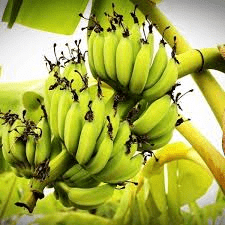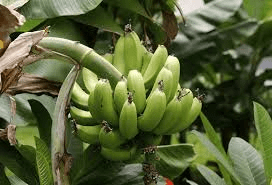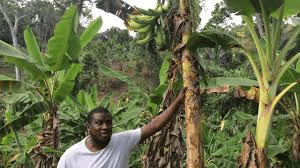Plantains (Musa paradisiaca) are related to banana. They look quite similar and are, in fact, morphologically similar, but while bananas are grown for their sugary fruit, growing plantains are cultivated for their firmer, starchy fruit.
Both are members of the Musa genus and are technically large herbs and their fruit classified as berries. Plantains and their cultivated ancestors originated on the Malaysian peninsula, New Guinea and Southeast Asia and can attain heights of from 7-30 feet (2-10 m.).
Plantains are a hybrid of two species of banana, Musa acuminata and Musa balbisiana. Unlike bananas though, which are eaten fresh, plantains are almost always cooked. Plantains are grown from a super long 12-15 foot (3.5-5 m.) underground rhizome.
The resulting plant has giant leaves (up to 9 feet (3 m.) long and 2 feet (0.5 m.) across!) wrapping around a central trunk or pseudostem. Flowering takes 10-15 months of mild temperatures and yet another 4-8 months to fruit.
Flowers are produced from the pseudostem and develop into a cluster of hanging fruit. In commercial growing plantain plantations, once the fruit is harvested, the plant is cut down soon to be replaced by pups that sprout up from the mother plant.
How to Grow Plantain Trees

Plantains are grown just like bananas, which if you live in USDA zones 8-11, you can grow too. I’m still jealous. Initial plantain plant care requires well-draining soil, regular watering and protection from wind or frost.
Choose a sunny, warm area of your garden and dig a hole that is as deep as the root ball. Plant the plantain at the same level it was growing in the pot. Keep the plantain 4-6 feet (1-2 m.) from other plants to give it plenty of room to spread.
Add 4-6 inches (10-15 cm.) of organic mulch around the tree, keeping it 6 inches (15 cm.) away from the psedostem. Spread this mulch out in a circle 4-6 feet (1-2 m.) wide around the tree to help the soil retain water and protect the plants roots.
Read Also: Things to Consider when Selecting a Site for Plantain Farming Business
(1) Propping Plantains
The heavy weight of the plantain bunch bends all bearing plants and can cause doubling (pseudo stem breaks), snap-off (corm breaks, leaving a part in the ground) or uprooting also called top-over whereby the entire corm with root comes out of the ground.
Plants are generally weak during the dry season and strong winds, nematodes and stem borers also increase the rate of loss. For these reasons, bearing plants always need support from 1 or 2 wooden props usually made of bamboo.
If a piece of bamboo is used, the support is placed along side the bearing plant and the top of the plant is tied to the bamboo. A lateral branch at the top of the bamboo prop sometimes forms a natural fork which can be used to support the plantain without being tied to it.
When 2 pieces of bamboo are used, the bunch and not the plant is supported in the first place. The bamboo props are crossed and form a fork. This fork is tied together with a rope and placed just underneath the bunch.
(2) Harvesting of Plantains

The bearing plant is cut and the bunch about 3 to 4 months old is harvested when 1 or 2 fingertips of the first hand start yellowing. The bunch usually then ripens within a week, meanwhile care has to be taken so that the bunch does not drop on the ground when the main plant is being cut.
The whole of the pseudo stem and foliage of the main plant is then chopped and spread over the soil as a mulch for the ratoon crop because if this is done, weevils may live and multiply on the intact pseudo stem.
Read Also: Weed Control Methods for Plantain Plantations
Plantain Plant Care
The number one rule when caring for plantain trees is don’t let them dry out. They love moist soil, not soggy, and need careful watching during hot, dry weather. The number two rule of plantain plant care is to protect the plant.
Cover it with a blanket during cold snaps and put a light bulb or string of holiday lights under the blanket. While the rhizomes will survive underground down to 22 degrees F. (-5 C.), the rest of the plant will die back during freezing temperatures.
Follow those two rules and caring for plantain trees is fairly simple. As with all plants, some feeding is required. Feed the plant once a month during the summer with a slow release 8-10-8 fertilizer.
A heavy feeder, a mature tree needs about 1-2 pounds (0.5-1 kg.), spread out in a 4-8 foot (1-3 m.) radius around the plant and then lightly worked into the soil. Prune off suckers with a pair of gardening pruners.
This will divert all the energy to the main plant unless, of course, you are propagating a new plant. If so, leave one sucker per plant and let it grow on the parent for 6-8 months before removing it.
When the fruit is ripe, cut it from the pseudostem with a knife. Then chop the tree down to the ground and whack up the detritus to use as mulch to be spread around the new plantain tree that will arise from the rhizomes.
Read Also: How to Grow Sugar Cane Minecraft in a Sugar Cane Farm Minecraft
Frequently Asked Questions
We will update this section soon.

